Does Pet Yoga Improve Overall Pet Wellness?
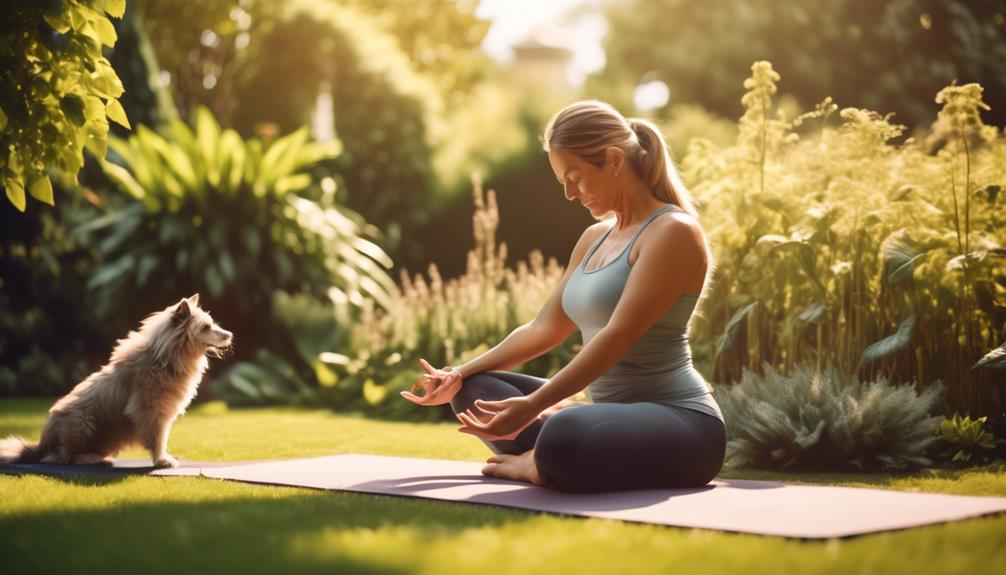
Pet yoga has the potential to improve overall pet wellness. It does this by providing physical exercise and mental stimulation. Additionally, pet yoga strengthens the bond between pet and owner.
By engaging in pet yoga, pets are able to get the exercise they need to maintain a healthy weight and prevent obesity-related health issues. The various poses and movements in pet yoga help to stretch and strengthen their muscles, improving their flexibility and overall physical fitness.
In addition to the physical benefits, pet yoga also provides mental stimulation for pets. The focus and concentration required in yoga poses can help to calm and relax pets, reducing anxiety and stress. This mental stimulation can also improve their cognitive abilities and problem-solving skills.
Furthermore, pet yoga strengthens the bond between pet and owner. By participating in an activity together, both pet and owner can experience a greater sense of connection and companionship. The shared experience of pet yoga can enhance communication and understanding between the two, deepening their bond and creating a positive and nurturing environment for the pet.
Overall, pet yoga is a holistic approach to pet wellness that combines physical exercise, mental stimulation, and the strengthening of the pet-owner bond. By incorporating pet yoga into their routine, pet owners can help improve the overall well-being of their pets and create a healthier and happier environment for both themselves and their furry companions.
Key Takeaways
- Pet yoga provides physical benefits such as enhanced flexibility, increased strength, improved balance, and reduced risk of injuries.
- Pet yoga offers mental benefits such as reduced stress and anxiety, enhanced emotional well-being, increased mindfulness and relaxation, and improved concentration.
- Practicing pet yoga deepens the bond between pet owners and their pets, promotes trust and companionship, enhances communication and understanding, and creates a positive and nurturing environment for the pet.
- Pet yoga originated in the early 2000s in the United States, combines traditional yoga poses with the inclusion of pets, and is influenced by the belief in the therapeutic benefits of animals and the recognition of the emotional and physical benefits of spending time with pets.
The Origins of Pet Yoga
What are the origins of pet yoga and how did it become a popular wellness practice for our furry friends?
Pet yoga, also known as 'doga,' is believed to have originated in the early 2000s in the United States. The practice combines traditional yoga poses with the inclusion of pets, primarily dogs, as active participants. The historical significance of pet yoga can be attributed to the growing interest in alternative and holistic approaches to pet care.
The origins of pet yoga can be traced back to the human-animal bond, which has been prevalent throughout history. Ancient civilizations, such as the Egyptians and Greeks, revered animals and believed in their healing powers. This belief in the therapeutic benefits of animals has influenced the development of pet yoga as a wellness practice.
In recent years, there's been a shift towards recognizing the emotional and physical benefits of spending quality time with pets. Pet yoga provides an opportunity for pet owners to bond with their animals while engaging in a mindful practice. The practice promotes relaxation, stress reduction, and increased flexibility for both pets and their owners.
The historical significance of pet yoga lies in its ability to enhance the well-being of both humans and animals. As more people seek holistic approaches to pet care, pet yoga has gained popularity as a unique and enjoyable way to promote wellness and strengthen the human-animal bond.
Understanding Pet Yoga's Impact
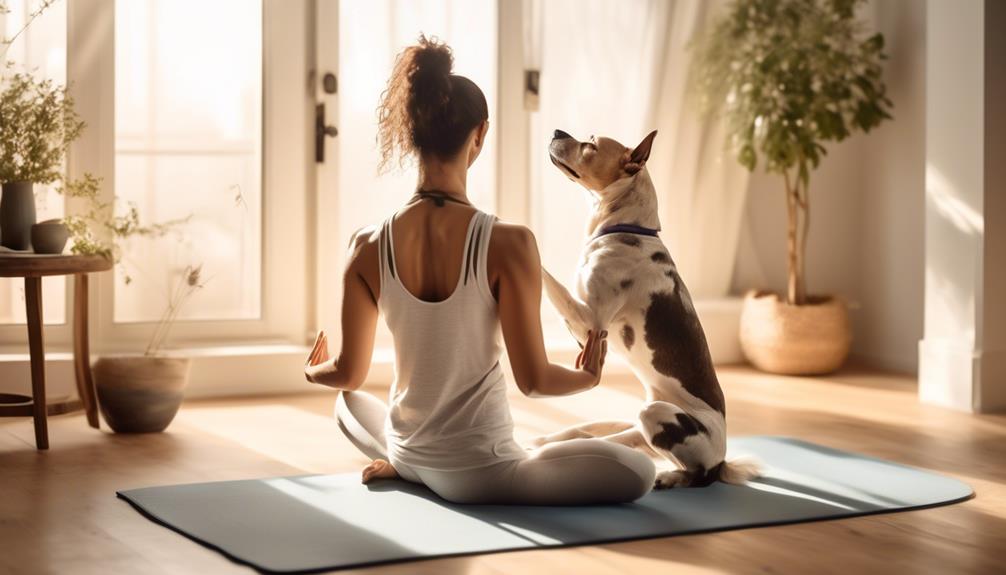
Pet yoga has been found to have numerous benefits for both pets and their owners.
One of the key impacts of pet yoga is the improvement in pet flexibility, as the various poses and stretches help to increase their range of motion.
Additionally, pet yoga also provides an opportunity for owners and their pets to bond and connect on a deeper level, fostering a sense of trust and companionship.
Benefits of Pet Yoga
Numerous studies have shown the tangible benefits that pet owners can experience from incorporating pet yoga into their wellness routines.
Pet yoga, also known as doga, has been found to improve pet posture and increase pet relaxation. One key benefit of pet yoga is its ability to improve pet posture. Just like humans, pets can develop poor posture from sitting or lying in the same position for extended periods. Pet yoga involves gentle stretching and poses that can help correct misalignments and improve overall posture.
Additionally, pet yoga can increase pet relaxation. The slow, deliberate movements and deep breathing exercises in pet yoga help calm pets' nervous systems and promote relaxation. This can be particularly beneficial for pets that are anxious or stressed.
Improving Pet Flexibility
In further exploring the benefits of pet yoga, one notable impact is its ability to enhance pet flexibility. Pet yoga involves a series of poses and stretches that target different muscles and joints in a pet's body. These poses help to improve range of motion and flexibility, allowing pets to move more freely and comfortably.
By practicing pet yoga regularly, pets can experience improved agility and coordination. The stretching and strengthening exercises help to increase muscle strength, which is essential for maintaining a healthy and active lifestyle. Additionally, pet yoga can also aid in preventing injuries by promoting better balance and stability.
Bonding Through Pet Yoga
Bonding through pet yoga can deepen the connection between pet owners and their furry companions. Pet yoga techniques involve practicing yoga poses with pets, allowing for physical and emotional bonding experiences. This shared activity can promote trust, relaxation, and increased communication between owner and pet. Pet yoga equipment, such as yoga mats or blankets, can provide a comfortable space for both the owner and pet to engage in the practice.
To understand the impact of bonding through pet yoga, consider the following table:
| Benefits for Pet Owners | Benefits for Pets |
|---|---|
| Improved physical fitness | Increased flexibility |
| Reduced stress and anxiety | Enhanced mental stimulation |
| Strengthened bond with pet | Improved socialization skills |
| Heightened sense of mindfulness and presence | Increased trust and security |
Physical Benefits of Pet Yoga
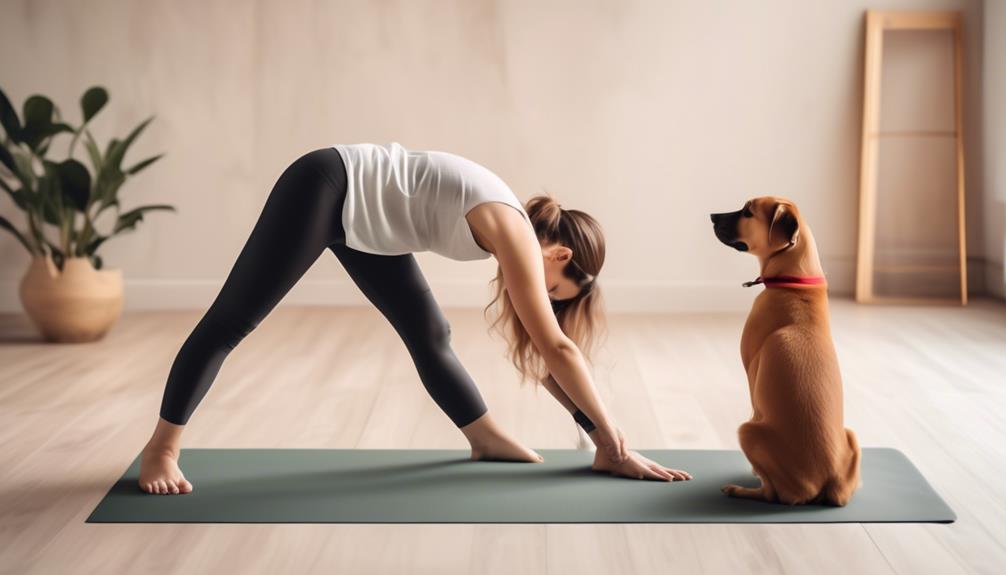
Pet yoga offers a multitude of physical benefits for both pets and their owners. Engaging in this practice can lead to improved agility and increased strength for both parties involved. Here are three specific physical benefits of pet yoga:
- Enhanced Flexibility: Pet yoga involves various stretching exercises that help improve flexibility in both pets and owners. This increased flexibility can lead to improved joint mobility and range of motion, reducing the risk of injuries and promoting overall physical well-being.
- Increased Strength: Pet yoga poses often require the use of muscles in both pets and owners. These poses help strengthen the core, limbs, and muscles throughout the body. Regular practice can lead to increased muscular strength, making daily activities easier and enhancing overall physical performance.
- Improved Balance and Coordination: Pet yoga poses often involve balancing on one leg or maintaining a stable position while stretching. These poses require concentration, balance, and coordination from both pets and owners. Regular practice can improve balance and coordination skills, leading to better stability and reducing the risk of falls or accidents.
Mental Benefits of Pet Yoga
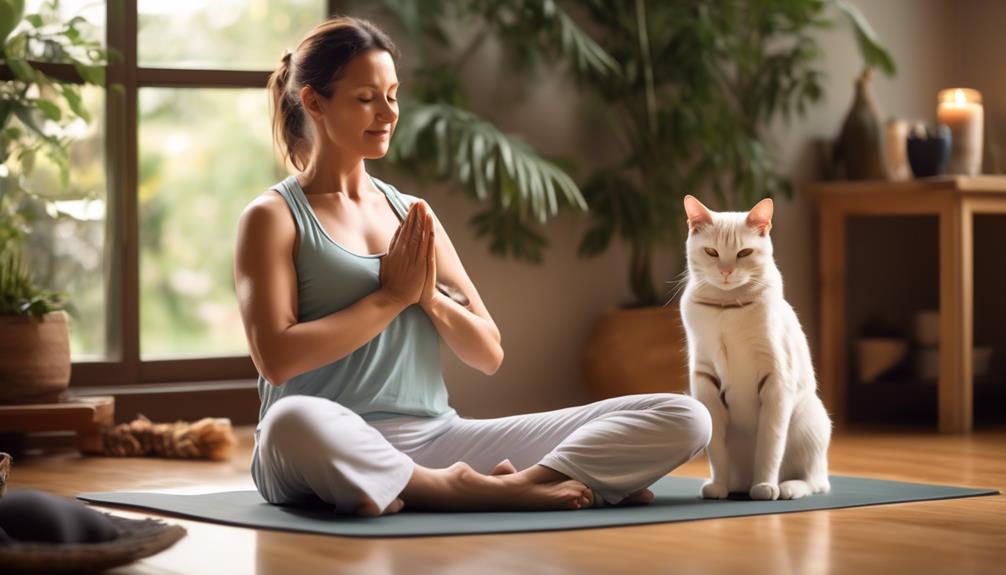
Pet yoga provides numerous mental benefits for both the pet and the owner.
Engaging in pet yoga can enhance emotional well-being by fostering a sense of connection and bonding between the pet and the owner.
Additionally, practicing pet yoga has been shown to reduce stress and anxiety, providing a calming effect on both the mind and body.
Enhances Emotional Well-Being
Engaging in pet yoga has been shown to have a positive impact on one's emotional well-being, promoting a sense of calmness and relaxation. Here are three ways in which pet yoga enhances emotional well-being:
- Stress reduction: The practice of pet yoga encourages deep breathing and mindfulness, which can help reduce stress levels. Spending quality time with your pet during yoga sessions can create a soothing environment that allows you to let go of worries and focus on the present moment.
- Bonding and connection: Pet yoga provides an opportunity for pet owners to strengthen their bond with their furry companions. The shared experience of practicing yoga together can deepen the emotional connection and enhance the sense of companionship between pet and owner.
- Emotional regulation: Engaging in pet yoga can help improve emotional regulation skills. The calming effects of yoga, combined with the presence of a beloved pet, can create a safe and supportive environment for practicing emotional self-regulation techniques, such as deep breathing and mindfulness.
Reduces Stress and Anxiety
Practicing yoga with a pet has been shown to effectively reduce stress and anxiety levels, benefiting one's mental well-being. Pet owners often find solace in the presence of their furry companions, and incorporating them into a yoga practice can amplify these benefits. Pets, particularly dogs and cats, have a calming effect on humans and are known to reduce feelings of stress and anxiety. Through the combination of mindful movements, deep breathing, and the soothing presence of a pet, pet yoga provides a dual benefit of reducing stress and promoting relaxation. In fact, studies have shown that engaging in pet yoga can lead to a decrease in aggression and an improvement in behavior. This table illustrates some of the mental benefits of pet yoga:
| Mental Benefits of Pet Yoga |
|---|
| Reduces stress |
| Alleviates anxiety |
| Improves overall well-being |
Strengthening the Bond Through Pet Yoga
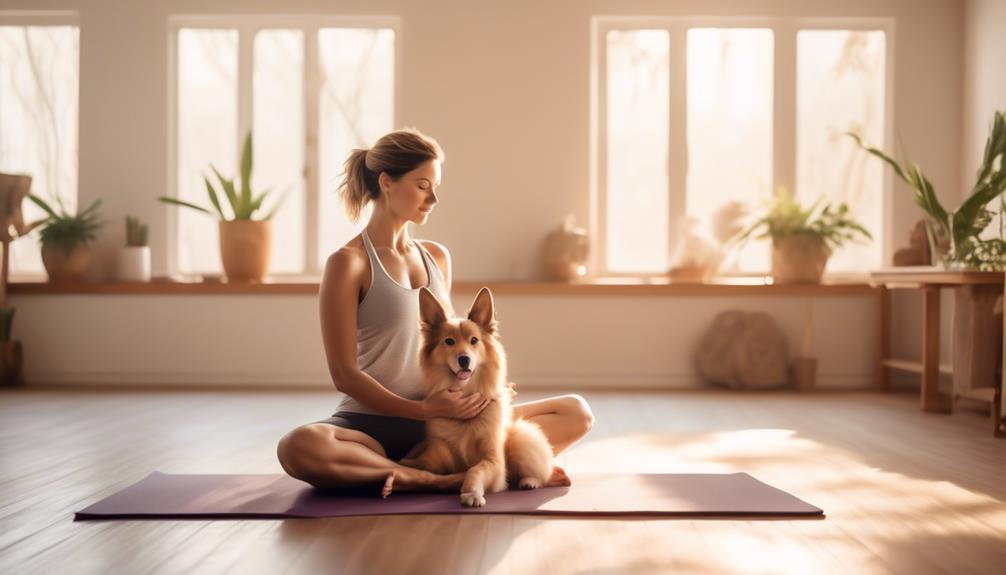
Through the practice of pet yoga, individuals can enhance the bond they share with their furry companions while promoting physical and mental well-being for both.
Pet yoga, also known as doga, involves incorporating pets into yoga poses and stretches. This can lead to several benefits, including:
- Improving pet communication: Pet yoga allows individuals to connect with their pets on a deeper level. By practicing yoga together, humans and animals learn to understand each other's body language and cues. This enhanced communication can strengthen the bond and improve overall pet wellness.
- Deepening the human-animal connection: Pet yoga provides an opportunity for humans and their pets to spend quality time together. Engaging in a shared activity like yoga promotes a sense of togetherness and enhances the emotional connection between the two. This can contribute to a happier and healthier relationship.
- Promoting physical and mental well-being: Pet yoga not only benefits the pet but also the human practitioner. The physical movements and stretches involved in pet yoga help improve flexibility, balance, and strength for both parties. Additionally, the mindfulness and relaxation techniques practiced during yoga can reduce stress and anxiety, promoting mental well-being for both the human and the pet.
Considerations for Practicing Pet Yoga
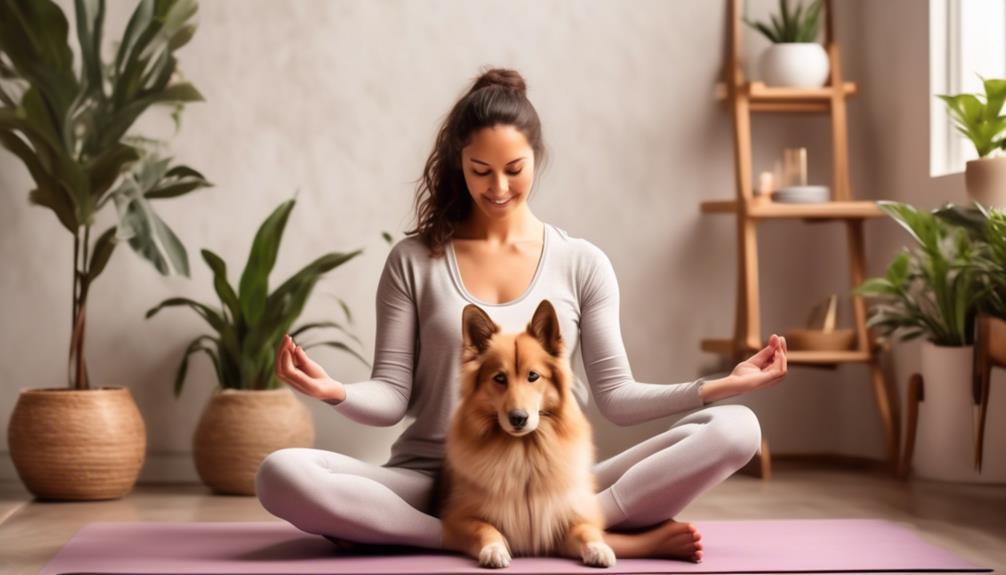
When incorporating pets into yoga practice, there are important considerations to ensure the safety and well-being of both the human and the animal. Pet yoga safety is crucial, as it involves the physical and mental health of both the practitioner and their furry companion. To ensure a safe and effective pet yoga session, it's essential to find a qualified instructor who specializes in this field.
A qualified instructor will have the necessary knowledge and experience to guide individuals in practicing pet yoga safely. They'll understand the unique needs of both humans and animals during a yoga session and be able to provide appropriate modifications and adjustments. It's important to research and choose an instructor who's received proper training in pet yoga and is familiar with the specific challenges and considerations that come with incorporating animals into a yoga practice.
Finding a qualified instructor can be done by asking for recommendations from friends, family, or fellow pet owners who've practiced pet yoga. Additionally, online directories and websites dedicated to pet yoga can provide a list of certified instructors in your area. It's crucial to thoroughly vet the instructor's qualifications, credentials, and experience before enrolling in their classes.
Tips for Getting Started With Pet Yoga
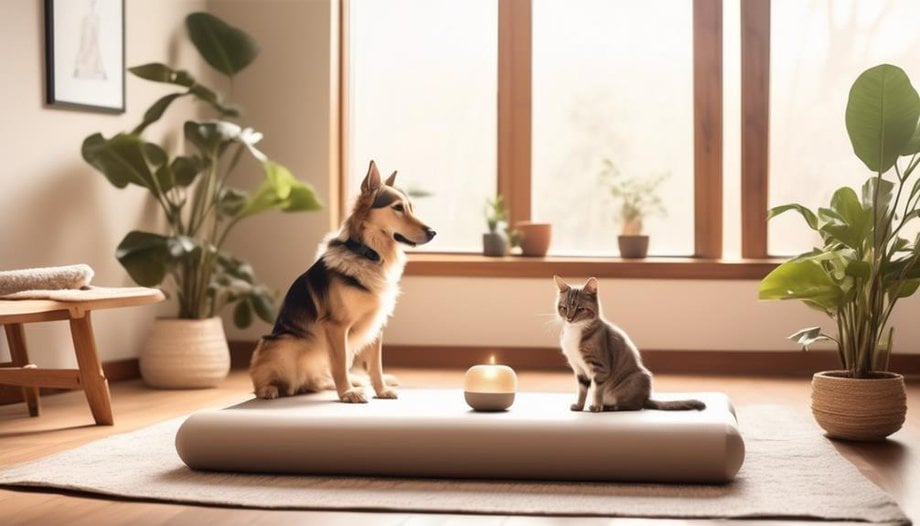
To embark on a successful journey of pet yoga, individuals should consider a few useful tips for a smooth and enjoyable experience with their furry companions. Here are three tips to get started with pet yoga:
- Starting Positions: It's important to choose the right starting positions for your pet yoga practice. Begin with simple poses that are comfortable for both you and your pet. Some popular starting positions include the seated position, where you sit facing your pet and gently stroke their fur, and the downward dog position, where your pet stretches their front legs and keeps their hind legs on the ground.
- Incorporating Props: Props can enhance your pet yoga experience by providing support and stability. Consider using a yoga mat or a blanket to create a designated space for your pet to relax and stretch. You can also incorporate toys or treats to keep your pet engaged and motivated during the practice. Remember to choose pet-friendly props that are safe and comfortable for your furry friend.
- Patience and Consistency: Like any new activity, pet yoga takes time for both you and your pet to get used to. Be patient and allow your pet to adjust to the practice at their own pace. Start with short sessions and gradually increase the duration as your pet becomes more comfortable. Consistency is key, so try to establish a regular pet yoga routine to reap the full benefits of this holistic practice.
Frequently Asked Questions
How Long Has Pet Yoga Been Practiced?
Pet yoga has been practiced for centuries, dating back to ancient civilizations. It has a rich history and is known to provide various benefits, including improved flexibility, reduced stress, and enhanced bonding between pets and their owners.
Are There Any Age Restrictions for Pets Participating in Pet Yoga?
There are no age restrictions for pets participating in pet yoga. In fact, pet yoga can provide numerous benefits for older pets, such as improved flexibility, balance, and relaxation.
Can Any Type of Pet Participate in Pet Yoga?
Any type of pet can participate in pet yoga, and it offers various benefits for their overall wellness. Pet yoga benefits include improved flexibility, reduced stress, increased bonding, and enhanced physical and mental health for different animals.
Are There Any Specific Poses That Should Be Avoided When Practicing Pet Yoga?
There are certain poses that should be avoided when practicing pet yoga, as they may put strain on the animal's body. It is important to introduce pets to yoga slowly and provide modifications that suit their individual needs.
Are There Any Risks or Potential Injuries Associated With Pet Yoga?
Pet yoga, like any physical activity, carries potential risks and types of injuries. It's important for pet owners to be aware of these risks and take precautions to ensure the safety and well-being of their pets during yoga sessions.









